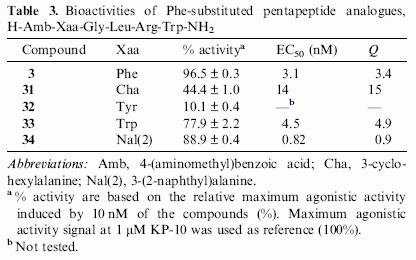Metastin (kisspeptin-54) is an endogenous ligand that modulates gonadotropin-releasing hormone (GnRH) secretion through the interaction with a G protein-coupled receptor (GPCR), GPR54. The short-chain C-terminal decapeptide amide, metastin (45-54) (kisspeptin-10), exerts the identical bioactivities to metastin, such as metastasis suppression of cancer cells and inhibition of trophoblast migration and invasion. In order to understand the structural requirement for GPR54 agonistic activity, structure-activity relationship (SAR) study on pentapeptide-based C-terminal metastin analogues was carried out. As a result, H-Amb-Nal(2)-Gly-Leu-Arg-Trp-NH(2)34 was identified as a novel GPR54 agonist that possessed the most potent GPR54 agonistic activity reported so far.
Tomita et al. Bioorg Med Chem. 2006 Nov 15;14(22):7595-603.
Metastin has been identified as a metastasis suppressor gene product that mediates its function through a G protein coupled receptor, GPR54. To refine insight into the critical pharmacophore for the activation of GPR54, we have conducted alanine and d-amino acid scanning on a biologically active metastin fragment (45-54). Based on these data and structures of peptides previously reported to activate GPR54, a series of shortened metastin (45-54) derivatives were synthesized and tested for the ability to induce GPR54 signaling. These biological experiments were performed in yeast containing human GPR54 that was coupled to the pheromone response pathway and a pheromone responsive lacZ reporter gene. Compounds 32, 33, and 39, which possess an N-terminal basic group and a C-terminal RW-amide motif, were strong agonists, similar to the level of metastin. This may provide an approach to reverse the pro-metastatic effect of metastin deletion in multiple malignant tumors.
Niida et al. Bioorg Med Chem Lett. 2006 Jan 1;16(1):134-7.

Structure–activity relationship study on GPR54 agonists was conducted based on the structures of FM052a 1 and FM053a 2. Optimization of each amino acid and the N-terminal functional group afforded a novel potent agonist 34 having a 3-(2-naphthyl)alanine.
Tomita et al. Bioorg Med Chem. 2006 Nov 15;14(22):7595-603.

Figure 3.Abbreviations: BisPy: bis[(2-pyridinyl)methyl]; desNLys: 6-aminohexanoic acid; Amb: 4-aminomethylbenzoic acid; desNArg: 5-guanidinopentanoic acid; Gu: guanidino.
Niida et al. Bioorg Med Chem Lett. 2006 Jan 1;16(1):134-7.

Tomita et al. Bioorg Med Chem. 2006 Nov 15;14(22):7595-603.

Tomita et al. Bioorg Med Chem. 2006 Nov 15;14(22):7595-603.


